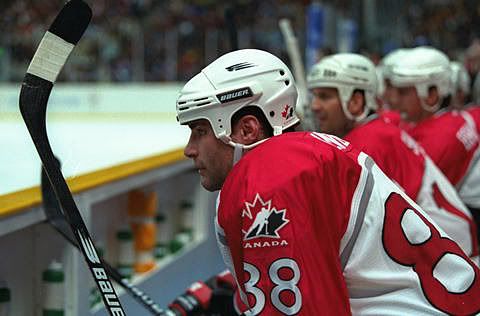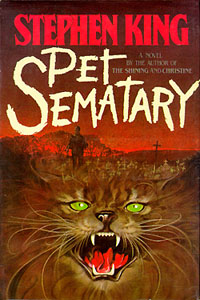

Since he was a teenager, a big man-sized teenager with quick feet and hands, Eric Lindros had been making hockey headlines. He was called "the Next One" as a youngster, when expectations for the burly center matched those of his superstar predecessors, Wayne Gretzky and Mario Lemieux. At the age of 15, Lindros was playing for the St. Mike's Junior B team. He had 67 points in 37 games and made a habit of walloping players who were sometimes six years older, racking up 193 minutes in penalties along the way. Though he was huge and talented, Lindros lacked confidence off the ice. When he was eligible for the junior draft as a 16-year-old, his mother and father asked the Sault Ste. Marie Greyhounds not to choose their son since the team was situated too far away. The Greyhounds drafted him anyway, as they had Wayne Gretzky in 1977, but, unlike Gretzky, Lindros refused to report. He played instead with a Detroit junior team, Compuware. He was pleased when the Greyhounds traded his rights to the Oshawa Generals, a team just outside Toronto, for three players, three future draft picks and $80,000. Prior to joining the Generals, Lindros made his first of three appearances at the World Junior Championships. Upon his arrival with the Generals, Lindros averaged two points a game and led the team to the Memorial Cup in 1990. He was named CHL Player-of-the-Year the next season after leading the OHL with 149 points and earning Canada another gold medal at the World Junior Championships in Saskatoon, topping the team with 11 points in the seven games. The junior draft debacle was repeated at the 1991 NHL Entry Draft. He was the best player available and the Quebec Nordiques had the first overall pick. Once again Lindros's parents informed Quebec management that Eric wasn't interested in playing for the Nordiques.


And once again the team ignored the complaints and chose Lindros. He refused to report, beginning a long and dramatic year for the promising player and the Nordiques. Even though Lindros had never played in the NHL, he was invited to the Team Canada training camp for the 1991 Canada Cup. He silenced many critics who said he'd never played against the game's elite with his physical play and scoring ability, often dominating many of the best pro players in the game on his way to making the team and playing in the tournament. After his Canada Cup experience, Lindros returned for his third World Junior Championship in 1992 in Lindros stayed in the Canadian national team program for the 1991-92 season, winning a silver medal at the Albertville Olympics in 1992 rather than joining Quebec in the NHL. In June 1992 the Nordiques at the draft finally arranged a trade. There was initially some confusion about which of two teams actually made a trade for Lindros first. The New York Rangers and the Philadelphia Flyers both felt they'd obtained the phenomenon. It was decided that the Flyers had indeed consummated a trade, sending six players (including Peter Forsberg, Mike Ricci, Ron Hextall and Steve Duchesne), two first-round draft choices and $15 million to the Nordiques for Lindros. The players who went to the Nordiques established Quebec, and later Colorado when the franchise moved, as a championship contender and then Stanley Cup winner in Denver. Life wouldn't be as easy in Philly for Lindros, who, despite a huge contract that paid him approximately what his boyhood idol Mark Messier earned, still hadn't played a game in the league. In his first season, in 1992-93, he was met with an outpouring of anger when he visited Quebec. But he set a Flyers record in his first season with 41 goals and improved his offensive totals over the next two seasons while maintaining a combative edge to his play. In 1994-95, the lockout-shortened season, Lindros tied with Jaromir Jagr for the scoring lead, and though he lost the Art Ross Trophy because he scored fewer goals, he won the Hart Trophy as the league's most valuable player and captured the Lester B. Pearson Award.

The Flyers began to round into form with Lindros as its captain in 1995-96. His line with John LeClair and Mikael Renberg came to be known as "the Legion of Doom" and beat up opposing defense to help Lindros score 115 points. Lindros added to his impressive international resume at the 1996 World Cup, though Team Canada fell short of expected victory. The next season in the NHL, he returned from a nagging knee injury as Philadelphia marched all the way to the Stanley Cup finals, leading all playoff scorers with 26 points en route to a heartbreaking loss to Detroit. Lindros's ascension to the top ranks of the game became complete when he was made Team Canada's captain for the 1998 Nagano Olympics. Injuries continued to haunt him near the turn of the century, taking different forms as his aggressive ways took a toll on his huge body. His younger brother, Brett, was forced out of the league after receiving one too many concussions in 1996 and Eric missed the 1999 playoffs with a collapsed lung that forced him to watch the Flyers from the sidelines as they lost their series with the Toronto Maple Leafs. Lindros's 1999-00 season was a shambles. He suffered four concussions, the last the result of a devastating hit from New Jersey's Scott Stevens in the Stanley Cup semifinals, that left his career in doubt. In the fall of 2000, Lindros demanded a trade to Toronto, but after a year in which Clarke refused to accommodate him, Lindros was sent to New York to resume his career with the Rangers. Upon his arrival in the Big Apple, Lindros has had seasons of 73 and 53 points while representing his country for the third time at the 2002 Winter Olympics in Salt Lake City, adding a gold medal to his previous silver that he won in 1992 in Albertville. Injuries continued to plague Lindros in 2003-04, limiting the burly winger to a mere 39 games.

Babe of the week - RACHEL BLANCHARD




Song for the day - "In My Time Of Dying" - BIG SUGAR





































































































































































